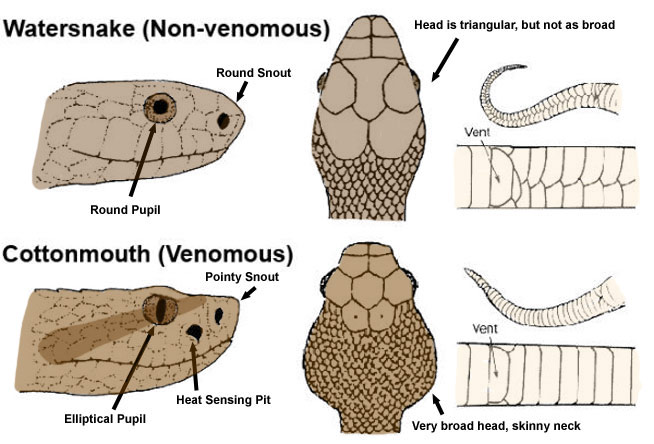It's impossible to tell for sure if a snake is venomous, or as some people say, poisonous, just by looking at certain features. There are three major myths people seem to believe in:
1) MYTH: It had a triangular head!
FACT: Pretty much all snakes, like 99%, have triangular heads. It's true that the venomous pit vipers have VERY broad heads, but then again, these are very fat snakes in general.
2) MYTH: It had a pattern!
FACT: A lot of snakes have patterns. And some venomous ones don't have any pattern. It seems that just because of diamondback snakes or coral snakes, people think that snakes with patterns
are dangerous. But most common harmless snakes, like Garter Snakes, Corn Snakes, Milk Snakes, etc. have distinct patterns.
3) MYTH: It rattled its tail!
FACT: This is a common behavior for most snakes. Rattlesnakes just so happen to have rattles that amplify the sound. But when the tail of a safe snake rattles against dry leaves, it sounds just like a rattlesnake!

TOP 3 MOST COMMON TRAITS OF VENOMOUS SNAKES:
1) It is big and fat (all in the USA, except that red-black-yellow coral, are fat pit vipers)
2) It is a rattlesnake, with real rattles on the end of its tail
3) It has elliptical pupils (but I doubt you're close enough to look)
Here, take a look at photos of the most common venomous snake species in the USA: Copperhead,
Cottonmouth,
Diamondback,
Coral Snake
Some creatures in nature were made to bamboozle us. Birds are notoriously hard to specify gender, so difficult to sex that it usually requires genetic testing to determine. Certain lizards and fish blend in so well with their surrounds that we might step on them without a second thought, and some creatures have patterns on them that make them look like something else. Thankfully, when it comes to snakes, though they all share the same long, lean body, there are definite ways to tell a venomous snake from a non-venomous one.
There are some drawbacks to determining a snake’s killing potential. Pupil size, for example, can often tell you a poisonous snake from a non-poisonous snake; however, discerning this would lead you dangerously close to the creature itself. Most poisonous snakes have a pupil that resembles a cat’s; an oblong shape with peaked ends, like a slit in the center of the eye. Non-venomous snakes usually have round pupils. There is always the exception. The coral snake, a very venomous snake in the United States, has round pupils.

Other body characteristics can help you play detective. Color can be a good indicator of a venomous snake, though again, there are always exceptions to the rule. Most solid colored snakes are not poisonous. The most colorful the snake, the more wary of it you should be. Venomous snakes also have a more triangular head, whereas non-venomous snakes will have a rounded jaw. The shape of the face has to do with the location of the venom sacks, so triangular= beware! If the snake has a rattle, it is venomous. Only rattlesnakes have rattles. Some snake species will flick their tails in a similar fashion, but only the rattlesnake has the mechanism that creates the sound associated with the species. Venomous snakes may have a divot in between their eyes for heat sensing. This physical attribute is most present in vipers and is a good indication of poisonous standing.
Behavior can also indicate poisonous or non-poisonous. Water snakes, for example, come in both varieties, but only poisonous snakes will swim with their entire bodies visible on the water. This is because venomous snakes swim with their lungs inflated, whereas a harmless water snake will swim with its body submerged.
There is one snake that is the exception to many of the above rules. The coral snake is a very poisonous snake but does not have a heat sensor, triangular face, or slit-like pupils. The color of a coral snake, however, is a dead giveaway.
Click here to read about the differece between poisonous vs. venomous snakes.
If you encounter a snake that has any one of the above characteristics, stay away from it. It may be harmless, but it may be poisonous. There is no need to take a chance when you can simply skirt around the creature and leave it be. If you are hiking or travelling in an unfamiliar area of the country, take some time an research the native snakes before you head out. Being able to recognize a poisonous animal is the easiest way to avoid it. In fact, most people living in the United States do not know what the major poisonous species are. Almost everyone can name a rattlesnake, but what about the others? Would you know a deadly viper if you saw one? Probably not. Even memorizing tricks about identifying venomous snakes should not be relied on in a moment of doubt. Too many exceptions are out in nature, and it does not make sense to risk your life over a snake. Learn the individual snakes and their characteristics. Being prepared is all it takes to stay safe.
You basically have three options for getting rid of your snake(s). First,
you can call a professional wildlife expert from my below directory.
This person can catch and remove the snake(s) and take other actions
necessary to solve the snake problem. Second, you can purchase a snake
trap if you wish to catch the snake yourself. Third, you can modify your
land and seal up your house to help keep snakes away and out of the
house.